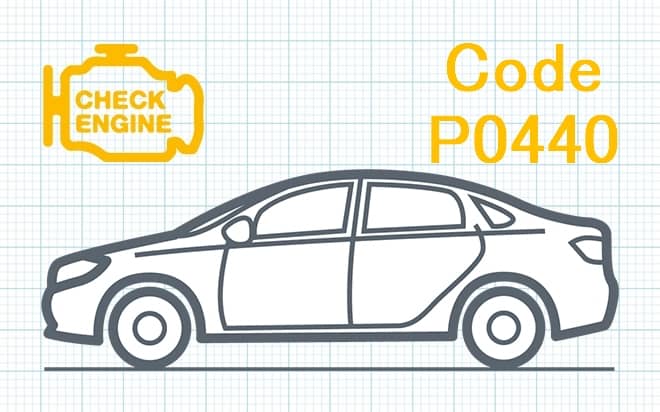
P0440 Malfunction of the control system for the removal of fuel vapor
Content
P0440 – OBD-II Trouble Code Technical Description
Trouble code P0440 indicates a malfunction of the evaporative control system.
What does the fault code mean P0440?
Trouble code P0440 indicates a problem with the evaporative control (EVAP) system. This means that the engine control module (ECM) has detected a leak in the evaporative capture system or a malfunctioning evaporative pressure sensor.

Possible reasons
Some possible reasons for the P0440 trouble code:
- Leak in the evaporative emission system: The most common cause is a leak in the fuel vapor capture system, such as a damaged or disconnected fuel tank, fuel lines, gaskets or valves.
- Defective fuel vapor pressure sensor: If the fuel vapor pressure sensor is faulty or has failed, this can also cause the P0440 code to appear.
- Malfunction of the fuel vapor capture valve: Problems with the evaporative control valve, such as clogged or sticking, can cause the evaporative control system to leak or malfunction.
- Problems with the fuel tank cap: Incorrect operation or damage to the fuel tank cap may result in fuel vapor leakage and therefore P0440.
- Problems with the fuel tank ventilation system: Incorrect operation or damage to fuel tank ventilation system components such as hoses or valves may also cause fuel vapor leakage and cause this error message to appear.
- Engine Control Module (ECM) malfunction: Sometimes the cause may be due to a malfunction of the engine control module itself, which does not correctly interpret signals from sensors or cannot properly control the evaporative emission system.
What are the symptoms of a fault code? P0440?
In most cases, the P0440 trouble code is not accompanied by obvious symptoms that would be noticeable to the driver while driving, but sometimes the following symptoms may appear:
- Check Engine Light Appears: The main symptom of the P0440 code may be the appearance of the Check Engine light on your vehicle's dashboard. This indicates that the engine management system has detected a malfunction.
- Minor performance degradation: In rare cases, if the fuel vapor leak is significant enough, it may result in slight deterioration in engine performance such as rough running or rough idling.
- Fuel smell: If a fuel vapor leak occurs in close proximity to the vehicle interior, the driver or passengers may smell fuel inside the vehicle.
- Increased fuel consumption: It is possible that fuel vapor leakage may cause a slight increase in fuel consumption as the system may not be able to properly capture and process fuel vapor.
It is important to note that these symptoms can also be caused by other problems with the evaporative control system, as well as other engine problems. Therefore, it is recommended to carry out diagnostics using a scanner to accurately determine the cause of the P0440 code.
How to diagnose a fault code P0440?
Diagnosis for DTC P0440 typically includes the following:
- Checking the Check Engine indicator: First, you should connect the OBD-II scanner to your vehicle's diagnostic port and read the P0440 error code. This will help confirm the problem and begin further diagnosis.
- Visual inspection of the fuel vapor recovery system: Inspect the evaporative control system, including the fuel tank, fuel lines, valves, evaporative recovery valve, and fuel tank for visible damage, leaks, or malfunctions.
- Checking the fuel vapor pressure sensor: Check the fuel vapor pressure sensor for a correct signal. If the sensor is faulty, it should be replaced.
- Testing the Evaporative Capture Valve: Check the operation of the evaporative control valve for blockage or sticking. Clean or replace valve as necessary.
- Checking the fuel tank cap: Check the condition and proper operation of the fuel tank cap. Make sure it creates a proper seal and does not allow fuel vapors to escape.
- Checking the fuel tank ventilation system: Check the condition of the fuel tank ventilation system hoses and valves for damage or blockages.
- Checking the Engine Control Module (ECM): Test the engine control module (ECM) to ensure it is functioning correctly and reading sensor signals correctly.
- Additional tests: If necessary, perform additional tests such as a resistance test in the control circuit or a smoke test to detect leaks.
After completing these steps, you can determine the cause of the P0440 code and begin making the necessary repairs or replacing components.
Diagnostic errors
When diagnosing DTC P0440, the following errors may occur:
- Unreasonable repairs or replacement of components: The P0440 code can be caused by several different problems with the evaporative emission control system. Incorrect diagnosis can lead to unnecessary replacement of components, which can be ineffective and costly.
- Skipping important diagnostic steps: A complete diagnosis of the evaporative emission control system must be performed, including visual inspection, sensors, valves, and control circuit testing. Skipping important steps may result in missing the root cause of the problem.
- Ignoring other error codes: Sometimes the P0440 code may be accompanied by other error codes that also need to be diagnosed and resolved. Ignoring other error codes may result in incomplete diagnosis and faulty repairs.
- Incorrect interpretation of scanner data: Sometimes the data received from the scanner can be misinterpreted, which can lead to an incorrect diagnosis. It is important to correctly analyze the scanner data and look for additional evidence of the problem.
- Inadequate testing: Some components, such as valves or sensors, may not operate reliably but produce signals that appear normal when tested. Insufficient testing can lead to hidden problems being missed.
- Lack of accuracy and caution: When diagnosing the fuel system, you must be careful and careful to avoid damaging components or igniting fuel vapors.
How serious is the fault code? P0440?
Trouble code P0440, which indicates problems with the evaporative emission system, is usually not critical to the safety or performance of the vehicle. However, its appearance may indicate potential problems that could lead to damage to the emission system, increased emissions of pollutants and negative impacts on the environment.
Although a vehicle with code P0440 may continue to function normally, it is recommended that you have a professional diagnose and fix the problem as soon as possible. Failure to correct the cause of the P0440 code may result in further damage to the evaporative emission control system and increased emissions of harmful substances into the environment. Additionally, in some jurisdictions, a vehicle with an active DTC may fail inspection or emissions testing, which could result in fines or other negative consequences.
Overall, although a P0440 code is not an emergency, it still requires attention and repair to keep your vehicle running properly and minimize harm to the environment.
What repair will help eliminate the code? P0440?
Troubleshooting DTC P0440 usually requires the following steps:
- Finding and fixing leaks: First, any leaks in the evaporative emission system must be found and repaired. This may include replacing damaged or worn seals, gaskets, valves or hoses.
- Checking and replacing the fuel vapor pressure sensor: If the fuel vapor pressure sensor is faulty, it must be replaced. You must ensure that the new sensor meets the manufacturer's specifications.
- Checking and cleaning the fuel vapor capture valve: If the evaporative control valve is blocked or stuck, it should be cleaned or replaced depending on the condition.
- Checking and replacing the fuel tank cap: If the fuel tank cap is damaged or faulty, it must be replaced.
- Checking and replacing other evaporative emission system components: This may include valves, hoses, filters and other system components that may be damaged or malfunctioning.
- Diagnose and repair other problems: If necessary, additional diagnostics and repairs may also be required for other problems, such as faulty engine control module (ECM) or other sensors.
It is important to conduct a thorough diagnosis to pinpoint the cause of the P0440 code before making any repairs. If you do not have the necessary experience or tools, it is recommended that you contact a qualified auto mechanic or service center for diagnosis and repair.
P0440 – Brand-specific information
Trouble code P0440 can occur on various makes of cars, some of them with their meanings:
- Chevrolet, GMC, Cadillac: P0440 means “Evaporative Emission Control System Malfunction”.
- Toyota, Lexus: P0440 is commonly referred to as “Evaporative Emission Control System Malfunction” or “Evaporative Emission Control System Malfunction Gross Leak Detected.”
- Ford, Lincoln, Mercury: This code typically means “Evaporative Emission Control System Malfunction” or “Evaporative Emission Control System Large Leak Detected.”
- Honda Acura: P0440 can be interpreted as “Evaporative Emission Control System Malfunction”.
- Nissan, Infiniti: For this brand, the P0440 code may also indicate “Evaporative Emission Control System Malfunction.”
Consult your specific vehicle's owner's manual or contact the manufacturer for more accurate information about the P0440 trouble code on your vehicle.

One comment
Mamuka
My car turns on and lights up two codes 440 and 542 and the car shuts off.